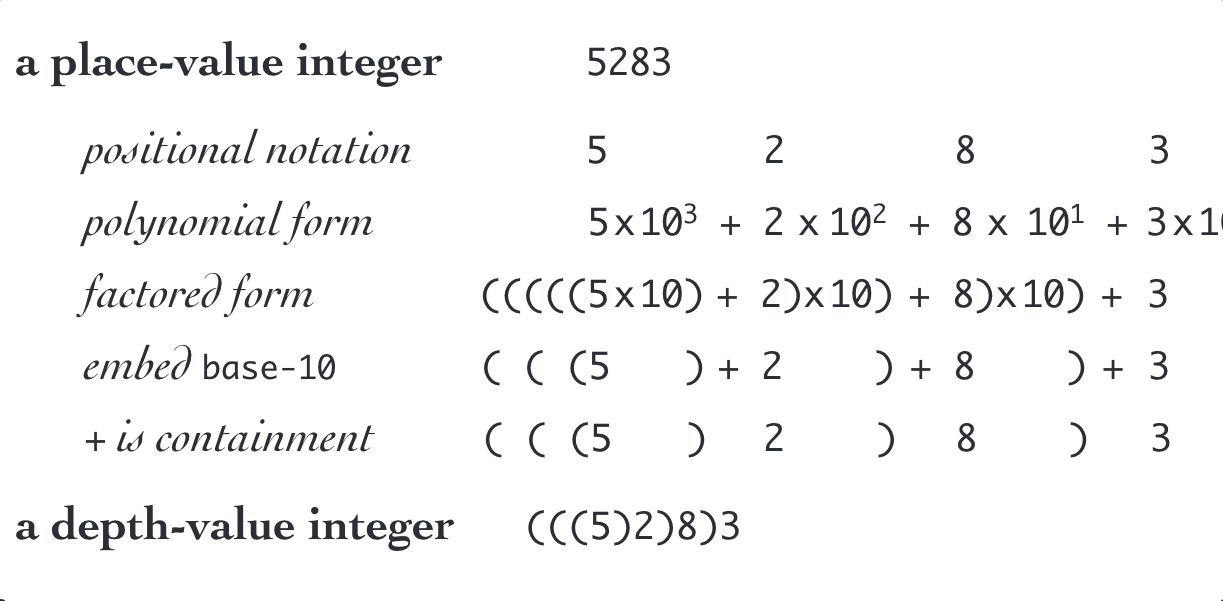To open up this question, we fall back on a concept of Structure based on William Bricken's Iconic Arithmetic.
Structure ⇒ Pattern-Matching ⇒ Remove Enclosing Brackets ⇒ Dots as Brackets ⇒ General Bracketing Theory
# Brackets
## Structure between Brackets
The Frame Type is structure *between* round- and square-brackets. The generic template collapses if either the type or the content is void-equivalent. There are categories of Frames that all have the same frame-type. In Arrangement collect gathers together framed-content that has in common the same frame-type. (Iconic Arithmetic, Vol. 1, p. 198)
It can also collapse for legal reasons, misuse, malware or security reasons.
The order of magnitude of a digit within a conventional number identifies …
of a digit within a conventional number identifies how many times that digit is multiplied by ten. Instead of increasing the power of a digit by moving to the next position on the left (thousands, hundreds, tens, units), depth-value increases power by depth of nesting. Crossing a boundary outward changes the order of magnitude by one power-of-ten, more generally by one power of an arbitrary base. 5283 in Positional Notation is (((5)2)8)3 in Depth-Value Notation. The depth-value form of 5003 is (((5)))3. …
> Do not be concerned by the extra burden of Brackets. Positional notation has the same burden. By convention we do not write the meanings of the left-to-right positions within the number. Instead we spend years as children learning to see them implicitly. With familiarity, the brackets too can be implicit. For example, the leading open parentheses can easily be omitted to yield, for example,
5)2)8)3 ☞ 5283

Figure 3-1: Place-value to depth-value
Figure 3-1 shows an example of the conversion from place-value to depth-value notation. Place-value is an abbreviation for numbers rendered as polynomial expressions, while depth-value is an abbreviation for numbers rendered as factored expressions. For convenience, we’ll consider both ensemble and depth-value forms to be implicitly bounded by a value-neutral container.
We consider forms to be implicitly limited by a value-neutral Container.
> […], most of us do conceptualize sets in terms of Container schemas, […]. However, when we conceptualize sets as Container schemas, a constraint follows automatically: **Sets cannot be members of themselves**, since **containers cannot be inside themselves**. Strictly speaking, this constraint does not follow from the axioms but from our metaphorical understanding of sets in terms of containers. The axioms do not rule out sets that contain themselves. However, an extra axiom was proposed by von Neumann that does rule out this possibility.
The concept of a container is tangible, not abstract.
~
The Two Level Diagram is one of the Guiding Diagrams. They are a means of drawing pictures of work in progress that can accompany this work until completion.
Bonus content, Wiki's Robot Scouts
[…] when they rave about how many lines of code they were able to delete. (Refactoring Improving The Design Of Existing Code, Foreword)
Ward hopes that by describing the diagram-induced restructuring, he can encourage the development of this workflow.
> An unattractively complex diagram prompted Ward to redesign a page central to Thompson's writing. He hopes that by describing this Episode, he can encourage the development of this workflow.
The Wiki's Robot Scouts should help us to delete code and/or text – or generally speaking: Story Snippets.
Floated for discussion before inclusion in Refactoring Wiki Pages or Good Wiki Citizen
Why not build a parallel Document that attempts to improve the organization? Why dinker with the original if its still changing? We can then rename or remove the original after the dust settles.
Deleting should not be used as a means of disagreement and control. This is a community wiki and should reflect its commonly acceptable practices and should accurately and sensibly present its concerns.
A reading of the Hebrew Scriptures, informed by good scholarship, offers an illustrative example. The compilers were redacters and editors, through and through. We have therefore inherited a rich fabric that contains the same stories and themes, retold over and over - but with each retelling reflecting a different Perspective. I suggest that the willingness of the editors/redactors to merge multiple tellings, without editing them to conform to a common viewpoint, is a deeply fundamental aspect of the value of this text as literature, history, and culture (regardless of our spiritual perspectives).
~
Sometimes Wiki pages get rearranged or reorganized. Sometimes we call this refactoring. Sometimes the information content of the Wiki is not being changed, it is just being reorganized, i.e. the design or architecture of the Wiki is being improved. Like Extreme Programming Re Factoring of code, this may be in preparation for more features being added, but …
We continue to suffer under one poor choice I (Ward) made early in the project: drag refactoring. This was a design goal. I had hoped that a carelessly organized set of pages could be drag and drop refactored into a better design.
We continue to suffer under one poor choice I made early in the project: drag refactoring. This was a design goal. I had hoped that a carelessly organized set of pages could be drag and drop refactored into a better design.
> Copying a paragraph is made hard too since you have to remember to hold the shift key down while dragging and ignore the fact that it seems to have moved the item anyway (It hasn't, refresh to see that.)
Here we are not interested in the shift key down topic. We focus on putting a paragraph into separate frames (pages).
To complete an operational description of round- and Square-Brackets, we will need an axiom that specifies how the two boundaries interact in configurations more complex than the double nesting of Inversion. Here is the James axiom of Arrangement. The axiom specifies an invariant structure across frames.